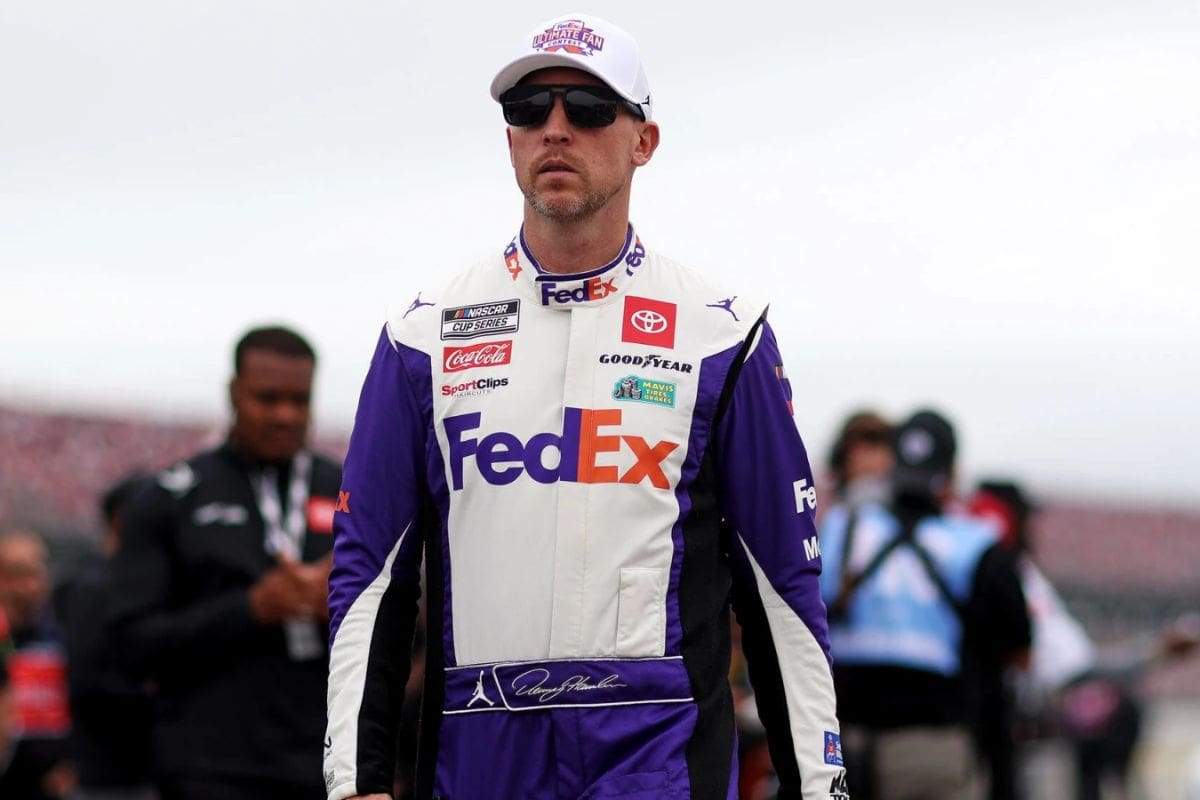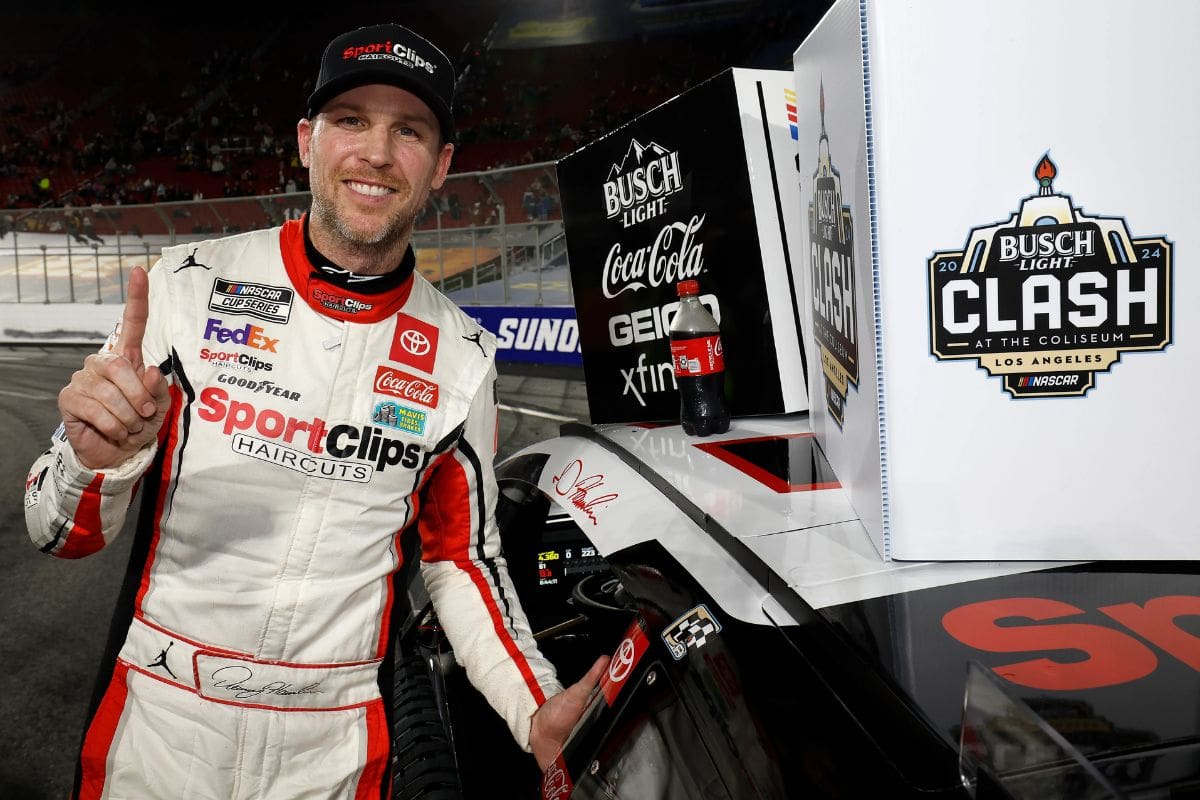Denny Hamlin Predicts High Crashes at IMS: As Denny Hamlin gears up for the upcoming race at Indianapolis Motor Speedway (IMS), he anticipates a high number of crashes, drawing insightful parallels to the notoriously tricky Pocono Raceway. Hamlin’s forecast is rooted in the narrow layout and limited passing opportunities at IMS, which he believes will demand exceptional precision and rapid decision-making from drivers. By comparing the intricate complexity of IMS to Pocono, Hamlin highlights the meticulous planning and adaptability required to succeed. This sets the stage for what promises to be an intense and unpredictable Cup Series race, where every maneuver could spell the difference between triumph and disaster.
Key Highlights
- Denny Hamlin predicts a difficult race at Indianapolis Motor Speedway with a high incidence of crashes.
- Hamlin compares IMS to Pocono Raceway, highlighting both tracks’ narrow layouts and challenging dynamics.
- IMS demands precision and quick decision-making due to its limited passing lanes and single preferred racing line.
- Aggressive moves during restarts and on long straightaways are expected to lead to multi-car incidents.
- Hamlin’s strategy focuses on maintaining a strong position and executing flawlessly to secure a victory.
Denny Hamlin’s Expectations for the Indianapolis Race
Denny Hamlin has voiced his anticipation for a tumultuous race at Indianapolis Motor Speedway, drawing parallels to the notorious challenges presented by Pocono Raceway. Speaking candidly on the Actions Detrimental podcast, Hamlin highlighted that the upcoming Cup Series race at IMS would likely be rife with chaos, a sentiment stemming from his thorough understanding of both tracks. His insights offer a detailed perspective on the complexities drivers will face, shedding light on the nuanced dynamics of racing.
“It will be a track-position type racetrack, Hamlin said about Indy. It’s going to be wild on restarts. I think you’ll have restarts very similar to Pocono where guys are trying to fit it in spots that are not there.” – Hamlin
Hamlin elaborated on the particular intricacies that make IMS a formidable battleground. He suggested that the layout and conditions at Indianapolis could precipitate a higher incidence of crashes, similar to what is often witnessed at Pocono. This comparison isn’t made lightly; Pocono is widely acknowledged for its demanding turns and long straights, which test a driver’s skill and endurance to the utmost. By likening IMS to Pocono, Hamlin effectively signals that drivers must brace for a race where precision and quick decision-making will be crucial.
“Pocono at least has two and a half to three legit lanes. If you put the cars side-by-side-by-side of each other, it’s three lanes wide, That means that’s actually two lanes wide when you’re actually racing because you got to leave a little bit of room.” – Hamlin
From an insider’s perspective, Hamlin’s expectations are deeply rooted in his extensive experience and keen understanding of race dynamics. He anticipates that IMS will challenge drivers with a volatile mix of high-speed sections and intricate turns, elements that can easily unsettle even the most seasoned professionals. His commentary hints at the strategic depth required to navigate such a track, emphasizing that mental sharpness and adaptability will be essential.
Track Characteristics and Challenges
In analyzing the track characteristics and challenges at Indianapolis Motor Speedway, it becomes evident that the narrow layout and limited passing lanes will heighten the difficulty of maintaining the best track position. Denny Hamlin’s insights underscore the unique intricacies of this iconic track, contrasting it sharply with the wider expanses of Pocono Raceway. While Pocono boasts two and a half to three legitimate lanes that can accommodate side-by-side racing, Indianapolis offers far less real estate, effectively reducing overtaking opportunities and amplifying the stakes of each maneuver.
The narrowness of Indianapolis Motor Speedway necessitates precision in car placement and demands a heightened level of skill from drivers. The track’s confinement restricts the margin for error, making each lap a high-stakes endeavor. Drivers must strategically position themselves not only to defend their position but also to capitalize on the few overtaking possibilities that arise. This inevitably leads to aggressive moves, especially during restarts where the pack is bunched tightly together.
Furthermore, the challenge extends beyond mere positioning. The track’s surface and its interaction with the tires add another layer of complexity. Managing tire wear while maneuvering through the tight confines requires a delicate balance between aggression and conservation. Drivers must be acutely aware of their car’s handling and the evolving track conditions, making real-time adjustments to maintain competitiveness.
Predictions for Racing Dynamics
Given the narrow boundaries and the expected aggressive maneuvers, the racing dynamics at Indianapolis Motor Speedway are anticipated to be characterized by a high frequency of multi-car incidents, especially in the latter stages of the race. The unique layout of the IMS, along with its single preferred racing line, creates a precarious battleground where drivers are pushed to the limits of their skill and strategy.
Denny Hamlin’s insights highlight a crucial aspect of the IMS track – the significant advantage of the inside line. ‘Indy is one lane. And when I say one lane, it’s one lane,’ Hamlin pointing out the challenge drivers encounter in maintaining the best positioning. The long straightaways, a signature feature of the speedway, serve as staging areas for high-stakes maneuvers where competitors, compelled by the need to gain track position, often try three-wide passes.
“Indy is one lane. And when I say one lane, it’s one lane. …We all know being on the outside is not going to be preferred at that place. You’re gonna want to be on the bottom, and then what’s going to happen is we’re going to go down these long straightaways, and everyone’s going to try three-wide bottom. Everyone’s going to try to merge, and usually you’re probably going to see a lot of wrecks late.” -Hamlin
As the race unfolds, the intensity rises. Every driver strives for the coveted inside line, fully aware that being pushed to the outside can determine the outcome of the race. This sense of urgency leads to daring overtakes and defensive driving, creating a particularly volatile environment in the later stages of the race. The combination of high speeds, narrow margins, and calculated aggression sets the scene for potential chaos.
Indeed, Hamlin’s prediction of numerous late-race wrecks is not just speculation but a well-thought-out evaluation based on experience. The IMS, much like Pocono, requires a delicate blend of precision and boldness, where even the slightest misjudgment can initiate chain-reaction crashes, reshaping the race’s result in a moment.
Hamlin’s Desire to Win and Strategic Approach
Hamlin’s passionate desire to secure a victory at the Indianapolis Motor Speedway is matched by his meticulous approach to race strategy, underscoring the critical importance of flawless execution from start to finish.
The return of the Brickyard 400 to the iconic oval track after three years of NASCAR racing on the infield road course marks a pivotal moment for Denny Hamlin. It’s a race he has yet to conquer, making his drive to triumph over the storied track more intense than ever.
“I want to win it bad,” Hamlin confessed on his podcast, epitomizing his determination. However, he is acutely aware that passion alone won’t secure the coveted victory. “I need to control what I can control, do my job on the racetrack, off the racetrack,” he added. This self-aware approach reveals a mature understanding of the multifaceted nature of competitive racing.
“I also know that I need to control what I can control, do my job on the racetrack, off the racetrack. This is gonna be a race that can be frustrating. You can have a very, very fast car and if you put that fast car in 10th place, it’s gonna be tough. It’ll be tough to come back from that. It comes from executing right when you unload to the checkered flag. I just got to make sure I do my job to the best of my ability and if we do, we’re gonna have a great shot. But I wanna win bad.” – hamlin
Hamlin’s strategy hinges on seamless execution, a process that begins the moment the car is unloaded. He acknowledges the potential frustration that can stem from the unpredictable nature of racing at IMS.
From the starting grid to the checkered flag, Hamlin aims to leave no margin for error. “I just got to make sure I do my job to the best of my ability and if we do, we’re gonna have a great shot,” he asserted. This relentless focus on precision and consistency could well be the key to ultimately capturing that elusive Indianapolis victory.
News in Brief: Denny Hamlin Predicts High Crashes at IMS
Denny Hamlin’s foresight regarding the Indianapolis Motor Speedway race emphasizes the complex tactical requirements similar to those at Pocono Raceway.
The expectation of multiple crashes, given IMS’s narrow configuration and restricted passing chances, highlights the need for accuracy and quick decision-making.
This evaluation showcases the strategic expertise needed to maneuver through such demanding conditions, paving the way for a thrilling and potentially chaotic Cup Series event at IMS.
ALSO READ: Kevin Harvick Backs Denny Hamlin’s Bold Take on Kyle Busch’s Struggles



